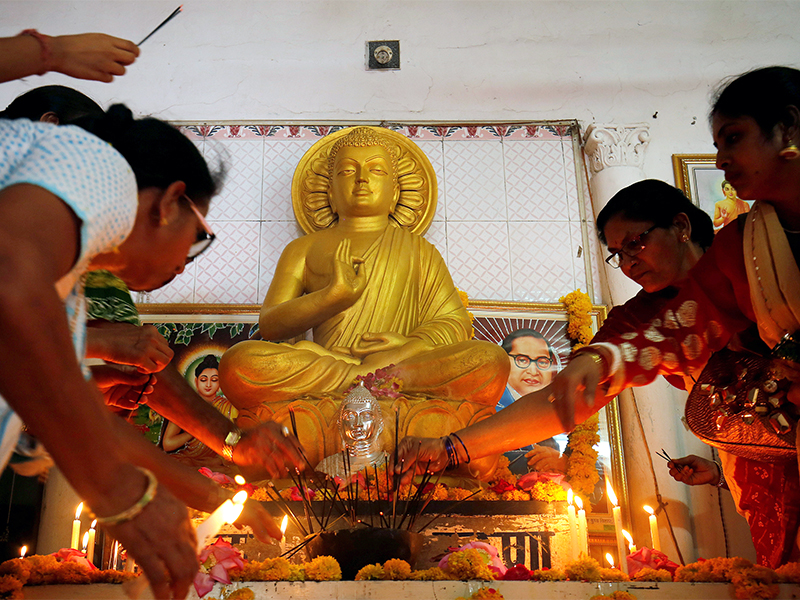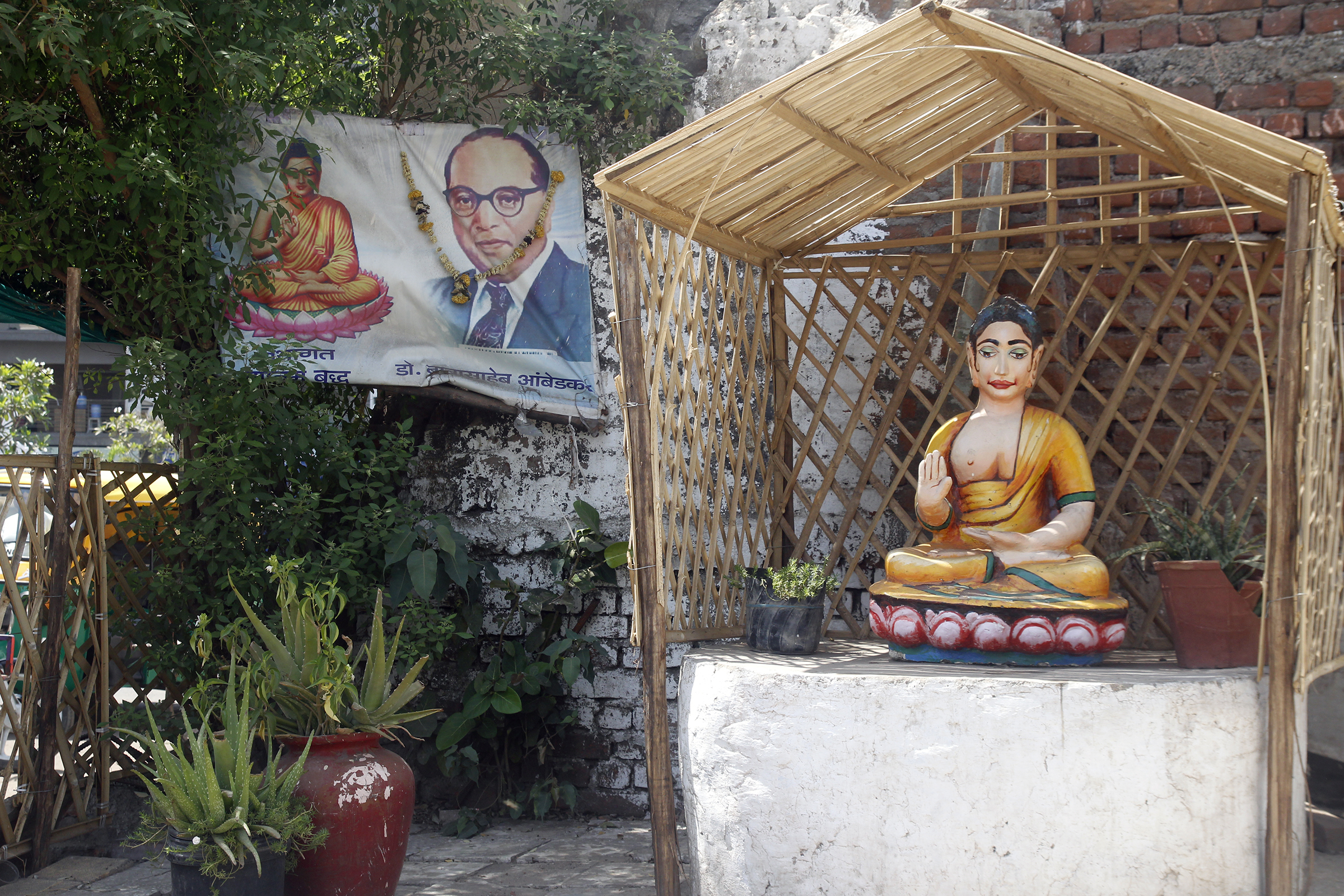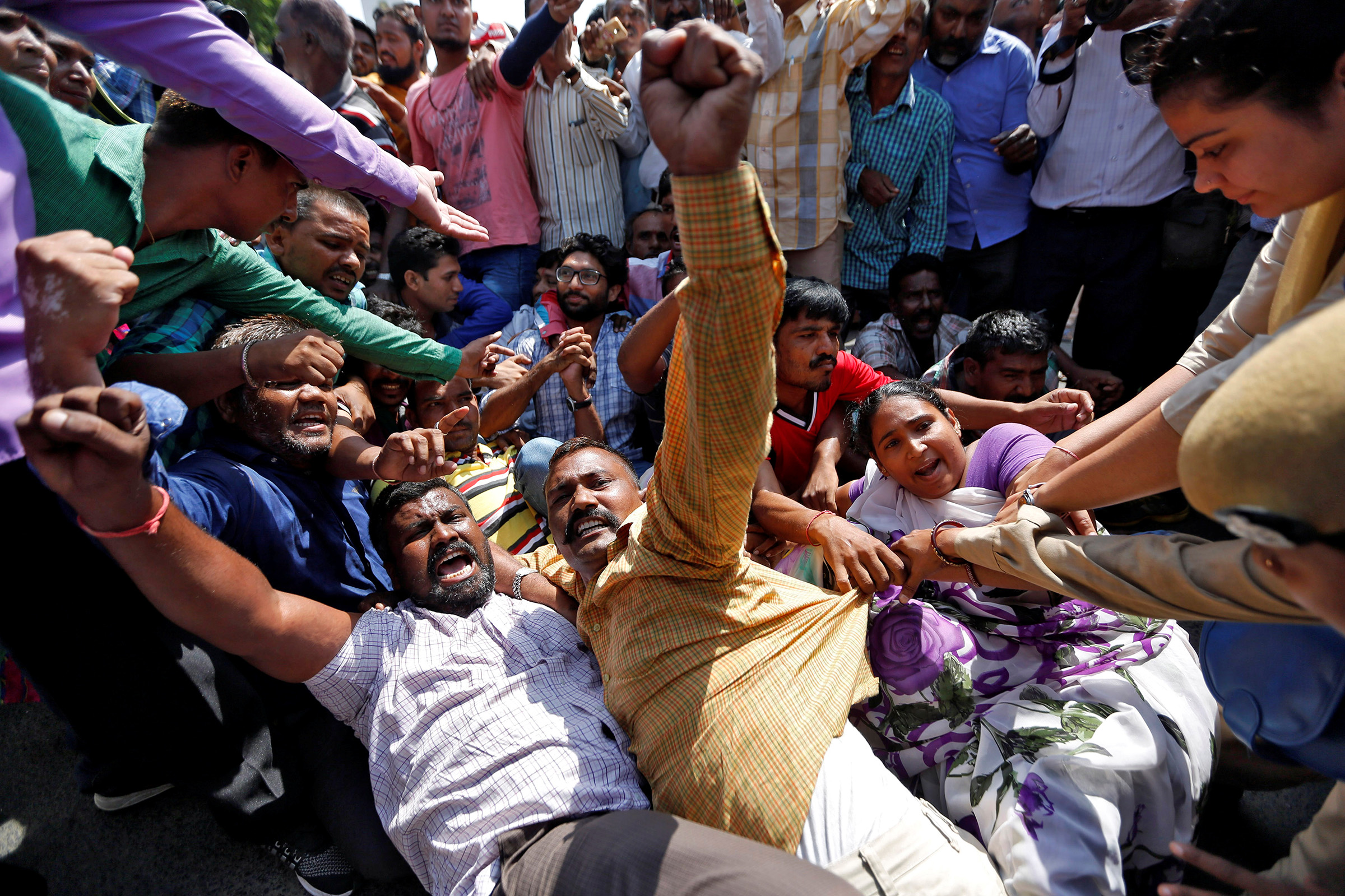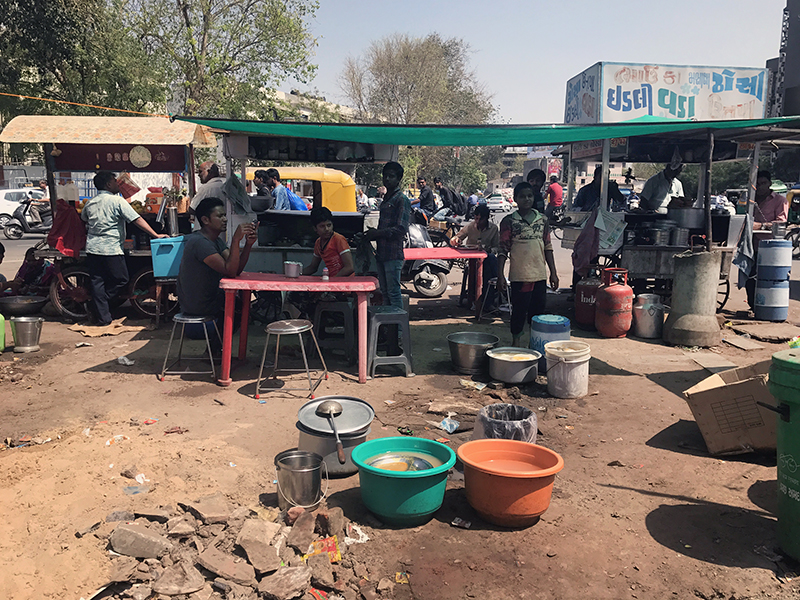

The Buddhist temple across from the New Cloth Market in Ahmedabad, in western India. Eight years ago, the original structure was destroyed by the municipal government for a housing project. Photo courtesy of Nicole Einbinder
AHMEDABAD, India (RNS) Dosa vendor Sunil Gagnath Sabkale watches over a fragile Buddhist temple across the street from a market where he sells his crepelike pancakes.
The temple consists of a small courtyard with a flimsy bamboo shelter built around a painted statue of the Buddha. But it is sacred to the hundreds of Buddhists whose parents converted to the faith from Hinduism decades ago.
Nearby, a flower garland is draped on a canvas depiction of B.R. Ambedkar, a prominent activist and signer of the country’s constitution.

Portrait of a young B.R. Ambedkar, architect of the Indian Constitution and founding father of modern India. Image courtesy of Creative Commons
Ambedkar, a victim of caste-based discrimination, is also known for converting from Hinduism, the country’s dominant faith, to Buddhism, a minority faith that represents less than 1 percent of the total Indian population, according to the 2011 census.
His decision to convert and publicly denounce the caste system sparked a neo-Buddhist revival in 1950s India that encouraged thousands of Dalits, like Sabkale’s family, to abandon Hinduism for the promise of a caste-free life.
Though carefully maintained, the temple exudes an air of impermanence. Thin wire and plastic ties hold the bamboo together. The shelter around the Buddha statue is lopsided. Local Buddhists say the 8-year-old structure is temporary and they hope the government fulfills its promise to replace it with a sturdier one.
The last two decades have witnessed a resurgence of interest in Buddhism by the Dalit community, said Deepak Dhammadarshi, the media and publicity officer of Manuski Trust, a human rights organization based on the teachings of Ambedkar.
More than 300 conversions took place across the state of Gujarat during an October ceremony — the direct response to a surge of caste-based violence.
[ad number=“1”]
“Our people who experienced atrocities are turning to Buddhism because they know the root of the problem is their identity,” Dhammadarshi said. “As long as they remain Dalits and untouchables, they are going to get this treatment of humiliation and discrimination and violence.”
In 2003, the Gujarat government passed the Gujarat Freedom of Religion Act, which outlawed conversions. Under this act, those who convert must receive prior permission from a district magistrate. But in 2006, an amendment was added that lumped together Jains, Buddhists and Hindus, so a Hindu converting to Buddhism is permitted.
Throughout India, Dalits have converted to other faiths, notably Christianity, to escape the caste system. Most Christian converts are from the states of Goa and Tamil Nadu.
The Gujarati Dalit movement has gained strength in response to caste-based violence, said Mangesh Dahiwale, a trustee of the Manuski Trust.
In July, upper-caste Hindu men attacked a Dalit family in the town of Una over allegations that they skinned a cow, a sacred animal in Indian society. And in Mumbai, a Dalit teenager was killed for flirting with a girl from the upper caste.

Demonstrators shout slogans during a protest organized by people of India’s low-caste Dalit community against what they say are increasing atrocities against the community in Ahmedabad, India, on Sept. 27, 2016. Photo courtesy of Reuters/Amit Dave
In 2013 and 2014, crimes against Dalits increased 20 percent, according to the 2015 report released by the National Campaign on Dalit Human Rights. Dalit women are particularly targeted, with a nearly 50 percent increase in the incidence of rape in the past decade.
“We don’t resort to violence but the nonviolent means of the Buddha,” Dahiwale said. “When people were beaten up and accused of skinning that cow, our people came in large numbers in the streets. We weren’t carrying guns or any weapons. Our only ammunition was the Buddhist flag.”
For Manjula Pradeep, a human rights activist from Gujarat and former director of the Dalit activist organization Navsarjan Trust, the decision to convert to Buddhism last year followed years of struggling as an atheist in a Hindu family.
[ad number=“2”]
Growing up, she often felt anger because of the restrictions placed upon her as a woman in Hindu culture. In 2001, her father forced her out of the family’s home.
A decade later, as he lay on his deathbed, Pradeep said, she realized she couldn’t remain bitter toward her father.
“When he passed away, the first thing I did was meditation and that totally changed my life,” she said. “Slowly, I started reading more about Buddha.”
Pradeep described her decision to embrace Buddhism as emotional, but challenging. Her mother called to tell her she was no longer her daughter because she wasn’t a Hindu.
[ad number=“3”]
Pradeep also faced hostility at her organization as a female leader and Buddhist convert. Shortly after converting, she was asked to leave her position. She is currently the consultant with the Manuski Trust.
In Gujarat, the situation of conversion is especially precarious, given the state’s role with Hindutva, the right-wing Hindu nationalist movement often associated with Prime Minister Narendra Modi’s BJP party.
In 2002, when Modi was chief minister of Gujarat, major riots broke out, resulting in the deaths of some 1,000 people, mostly Muslim, and the displacement of hundreds of thousands.
“Fear among Dalits is a major issue and they are living with a level of insecurity,” Pradeep said. “If they want to live in a fundamental(ist) Hindu society, they have to follow these norms and customs.”
Many of the converted still face hardships. The 450 second-generation Buddhists originally from the state of Maharashtra work at or near Ahmedabad’s New Cloth Market, employed as laborers, loading the trucks and preparing the material sold in the bustling bazaar.

The dosa hut where Sunil Gagnath Sabkale works is located outside of Ahmedabad’s New Cloth Market, in front of the makeshift Buddhist temple. Many second-generation Buddhists work at or near the market as laborers. Photo courtesy of Nicole Einbinder
The municipal government destroyed the original temple, constructed in 1975 by a community of newly converted Marathi Buddhists, to make way for housing projects. When the authorities came to demolish the temple, Buddhists stood in front of it to protect it, according to Sabkale, the dosa maker. He said police came and beat them, including his sister-in-law, Anjana Samadham, and her cousin, both of whom were badly injured.
In the aftermath of the attack, police told ambulances to not assist the beaten, Sabkale said.
The community was given $150,000 and a promise to rebuild the structure and replace the original statue, which was removed during the demolition.
Though the Buddhists remain optimistic that this will happen, some are skeptical. It is legitimate in India for the government to remove temples and shrines, even Hindu ones, for infrastructure projects, and, according to Giresh Gupta, an author and guide living in Ahmedabad, the replacement will never come.
Ratnakar Kosambi said the decision to convert to Buddhism decades ago was worth it. Now the regional chairman of the Triratna Buddhist Order in Ahmedabad, he said that despite the challenges of being a Gujarati Buddhist, Buddhism gives him peace of mind.
“I was searching for something higher. And when I came to Buddhism, I was immediately satisfied,” he said. “I am a free man.”
(Nicole Einbinder and Emily Churchill are students at Columbia University’s Graduate School of Journalism. Follow Einbinder on Twitter @NicoleEinbinder. Follow Churchill @e_m_churchill)
